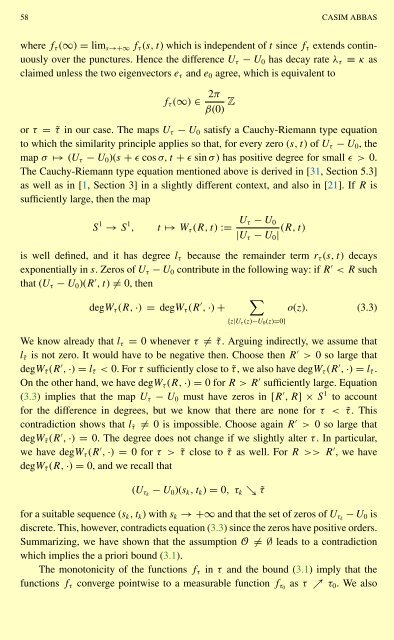NEAR OPTIMAL BOUNDS IN FREIMAN'S THEOREM
NEAR OPTIMAL BOUNDS IN FREIMAN'S THEOREM
NEAR OPTIMAL BOUNDS IN FREIMAN'S THEOREM
Create successful ePaper yourself
Turn your PDF publications into a flip-book with our unique Google optimized e-Paper software.
58 CASIM ABBAS<br />
where fτ (∞) = lims→+∞ fτ (s, t) which is independent of t since fτ extends continuously<br />
over the punctures. Hence the difference Uτ − U0 has decay rate λτ ≡ κ as<br />
claimed unless the two eigenvectors eτ and e0 agree, which is equivalent to<br />
fτ (∞) ∈ 2π<br />
β(0) Z<br />
or τ = ˜τ in our case. The maps Uτ − U0 satisfy a Cauchy-Riemann type equation<br />
to which the similarity principle applies so that, for every zero (s, t) of Uτ − U0, the<br />
map σ ↦→ (Uτ − U0)(s + ɛ cos σ, t + ɛ sin σ ) has positive degree for small ɛ>0.<br />
The Cauchy-Riemann type equation mentioned above is derived in [31, Section 5.3]<br />
as well as in [1, Section 3] in a slightly different context, and also in [21]. If R is<br />
sufficiently large, then the map<br />
S 1 → S 1 , t ↦→ Wτ (R,t) := Uτ − U0<br />
|Uτ − U0| (R,t)<br />
is well defined, and it has degree lτ because the remainder term rτ (s, t) decays<br />
exponentially in s. Zeros of Uτ − U0 contribute in the following way: if R ′ 0 so large that<br />
degW˜τ (R ′ , ·) = l˜τ < 0.Forτ sufficiently close to ˜τ,wealsohavedegWτ (R ′ , ·) = l˜τ .<br />
On the other hand, we have degWτ (R,·) = 0 for R>R ′ sufficiently large. Equation<br />
(3.3) implies that the map Uτ − U0 must have zeros in [R ′ ,R] × S 1 to account<br />
for the difference in degrees, but we know that there are none for τ < ˜τ. This<br />
contradiction shows that l˜τ = 0 is impossible. Choose again R ′ > 0 so large that<br />
degW˜τ (R ′ , ·) = 0. The degree does not change if we slightly alter τ. In particular,<br />
we have degWτ (R ′ , ·) = 0 for τ > ˜τ close to ˜τ as well. For R>>R ′ ,wehave<br />
degW˜τ (R,·) = 0, and we recall that<br />
(Uτk − U0)(sk,tk) = 0, τk ↘ ˜τ<br />
for a suitable sequence (sk,tk) with sk →+∞and that the set of zeros of Uτk − U0 is<br />
discrete. This, however, contradicts equation (3.3) since the zeros have positive orders.<br />
Summarizing, we have shown that the assumption O = ∅leads to a contradiction<br />
which implies the a priori bound (3.1).<br />
The monotonicity of the functions fτ in τ and the bound (3.1) imply that the<br />
functions fτ converge pointwise to a measurable function fτ0 as τ ↗ τ0. Wealso

















